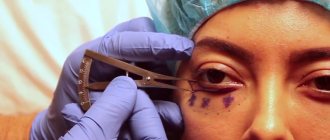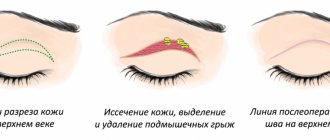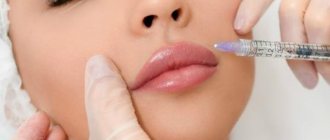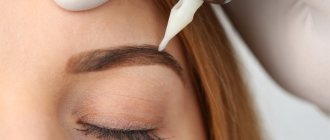In the modern cosmetology world, blepharoplasty is very popular. There is a misconception that this type of plastic surgery is a safe operation.
The consequences of blepharoplasty may be minor. If the operation is performed incorrectly, or if there are individual physiological characteristics of the body, complications after such an operation can significantly harm the health of the eyes.
What is blepharoplasty
According to medical terminology, blepharoplasty means plastic surgery, the main purpose of which is the correction of the eyelids and periorbital area. The main indications for this type of surgery include sagging skin on the eyelids, the presence of “fat bags,” and drooping lower corners of the eyes.
Depending on the area of operation, the following types are distinguished:
- Blepharoplasty of the lower eyelids.
- Upper eyelid lift.
- Circular blepharoplasty.
- Exophthalmos.
- Correction of Asian eye shape.
- Canthopexy.
In aesthetic medicine, blepharoplasty is performed in two ways:
- Transconjunctival. It is performed exclusively on the upper eyelids. It involves making an incision on the inner area of the eyelid in the natural folds of the eyes. Through it, fatty hernias and bags are removed and the skin is tightened.
- Using a laser. A universal operation that suits almost everyone and has a number of advantages. Laser blepharoplasty is used to correct the upper and lower eyelids.
Blepharoplasty requires a mandatory hospital stay and the use of anesthetic drugs. The duration of the manipulation is determined by the volume and complexity of the work, but on average it is 2 – 3 hours. The rehabilitation period after surgery is 1.5 – 2 weeks.
When agreeing to undergo surgery, you must fully understand what blepharoplasty is and what the consequences may be after it is performed.
Treatment of ptosis of the upper eyelid after Botox, Dysport, Xeomin
It is performed by administering proserine, taking increased doses of vitamins B1 and B6 or administering them in solutions using injections, performing physical procedures, laser therapy, and massaging the area of the upper third of the face. At the same time, all these measures only slightly help restore muscle function. Most often this happens naturally within 1-1.5 months.
Why complications may occur
Blepharoplasty belongs to the category of surgical interventions, after which negative consequences may occur. Their number and intensity depend on many factors.
The causes of postoperative complications after blepharoplasty are:
- Individual physiological characteristics of the body. The quality of the operation and the likelihood of complications are influenced by the presence of allergies, the location of blood vessels, and unforeseen reactions of the body during the formation of scars.
- Failure to comply with the surgeon’s prescriptions and recommendations by the patient during the preparatory and postoperative periods.
- Violation of surgical technique. As a rule, they occur when blepharoplasty is performed by a young doctor with minimal experience in performing similar operations.
- General surgical risks. Blepharoplasty is a traumatic type of surgery, which is performed on the thinned area of the periorbital region. To minimize the risk, in order to exclude contraindications to blepharoplasty, qualified specialists will refer the patient for examination.
In medical practice, there are cases when, after a successful operation and the absence of negative consequences, patients remain dissatisfied with the results. The main reasons in this case are the physiological characteristics of the body in the form of slow healing or high expectations from the operation.
When is it necessary to visit a doctor?
You should consult a surgeon when complications after blepharoplasty surgery on the upper or lower eyelids interfere with a normal lifestyle. For example, the eye does not close completely or is excessively dry - this may be the result of some problem that has arisen due to surgery.
In general, any changes in appearance or physical well-being that concern you should be a reason to visit a surgeon. This could be any visible defect at the operated site, or, for example, an increase in body temperature or nausea. A timely diagnosis and surgical treatment will help reduce to zero the risks of possible complications after eyelid blepharoplasty.
Following your doctor's recommendations is an important step towards a beautiful look.
The most common problems after plastic surgery of the upper and lower eyelids
Blepharoplasty is a traumatic type of surgery. Therefore, the likelihood of complications developing after it is very high. Taking into account various factors, experts identify a number of the most common problems from blepharoplasty. They are classified based on the reasons for their appearance.
With scarring
Plastic surgery to correct the eyelids involves excision of excess skin and fatty deposits. As a result of this, temporary sutures are formed.
The individual predisposition of the patient to the formation of keloid scars increases the likelihood of scars and cysts after surgery. If the neoplasms are small in size, then they are prone to self-resorption. Otherwise, surgery will be required to remove them.
You can restore the integrity of the skin at the initial stage through the use of ointments and hardware procedures. After several months, peeling or laser resurfacing will be required.
With functioning
Problems after blepharoplasty can also be functional. They manifest themselves in disturbances in the functioning of individual systems of the visual organs. Among these complications, the most common development is:
- Keraconjunctevita.
- Chemosa.
- Tears.
Functional complications include burning sensations and dryness of the mucous membrane of the eyes.
With aesthetics
Complications after blepharoplasty may be related to aesthetic appearance. An unsuccessful operation can provoke the development of complications in the form of:
- Blepharoptosis.
- Lagophthalmos.
- Eversion of the lower eyelid.
For many patients, such problems are the most terrible, since in addition to physiological pain they lead to dysfunction of a person’s psycho-emotional state.
Depending on the complications, to fully restore the functionality of the eyes and their aesthetic beauty, drug therapy, canthopexy or reoperation are performed.
Glass eye effect
One of the most common problems after lower eyelid blepharoplasty is the “glassy eyes” effect. The main reasons for this complication are:
- Removing too much skin.
- Violation of the surgical technique, which manifests itself in the absence of fixation of the canthal ligament.
- Formation of fibrous tissue in the postoperative period, which leads to inflammation.
- Anatomical predisposition.
- Loss of muscle tone and elasticity of the orbicularis muscle.
- Malnutrition of the fatty retina.
The effect of “glass eyes” after blepharoplasty can appear immediately after the operation or in the postoperative period. It causes not only aesthetic discomfort. This condition is accompanied by increased tearing, dry keratoconjunctivitis, burning of the eyes and pain in bright light.
Correction of such a problem is carried out exclusively through repeated surgery. It involves strengthening the ligamentous apparatus, reconstructing the lower eyelid by replacing the lack of tissue with a layer from the upper one. If necessary, NSAIDs and moisturizing eye drops are prescribed.
Care
Immediately after blepharoplasty, a sterile dressing is applied to the stitches. To reduce the formation of swelling, doctors advise applying ice compresses to the operated area in the first days. At this time, cosmetic and hygiene procedures on the face are contraindicated. You are allowed to wash your face no earlier than the next day.
We recommend: How do scars heal after blepharoplasty?
It is better to use cold water, rinsing the skin so that water does not get on the bandage and stitches. The procedure is useful to do, as it increases blood circulation and activates skin regeneration. It is usually necessary to use additional medications (ointments, creams, furatsilin solution for disinfection).
Skin care after suture removal consists of:
- the use of medications that accelerate healing (Levomekol ointment);
- using hypoallergenic and non-comedogenic products to cleanse the fatty ducts of the skin.
- applying creams that increase the elasticity of the skin;
- salon procedures - on the 5th day you can do a massage that stimulates blood circulation and accelerates the process of skin regeneration;
- additional procedures - treatment of hematoma or hemorrhage areas with Lyoton ointment for 7 days, but so that it does not get on the sutures.
Gel Lyoton
If the sutures after blepharoplasty do not tighten, then make sure that you follow the doctor’s recommendations:
- do not go to saunas and steam baths - if there is postoperative inflammation, then such activities only aggravate it;
- do not lift weights, do not take on heavy physical exertion, do not bend forward (all this contributes to the divergence of the seams);
- do not rub the operated area - firstly, this may cause infection in the wound, and secondly, it may delay treatment.
It is also extremely important in the first days after the procedure not to be in the open sun, not to go to the solarium. Wear sunglasses when going outside.
Much has been said about the negative impact of ultraviolet radiation on the process of tightening scars after surgery. The sun's rays promote strong collagen synthesis, making the scar dark and prominent.
If the patient’s medical history has a tendency to develop hypertrophic or keloid scars, the surgeon may prescribe additional procedures - inject the drug into the scar area or prescribe additional medications to prevent the proliferation of connective tissue: silicone-based ointments and gels (Zeraderm, Contractubex), silicone patch. In addition, they accelerate lightening and smooth out scars after blepharoplasty.
We recommend: How to remove seals on the lower eyelid after blepharoplasty?
In extreme cases, if the smoothing process is delayed, the surgeon performs a revision of the scar, which consists of removing excess connective tissue.
YouTube responded with an error: The request cannot be completed because you have exceeded your quota.
Rate this article:
- Related Posts
- What to do if your eyes are different after blepharoplasty?
- Is blepharoplasty dangerous?
- Why does swelling under the eyebrow after blepharoplasty not go away?
- How to get rid of dark circles under the eyes after blepharoplasty?
- Why do my eyes itch after blepharoplasty?
- Can hollows form under the eyes after blepharoplasty?
Early complications after plastic surgery
The etiology of early postoperative problems is associated with vascular damage, injury to delicate skin, or non-compliance with doctor’s recommendations during the preparatory and rehabilitation period. Modern aesthetic medicine identifies the following early complications after blepharoplasty.
Edema
Swelling after surgery during the first days is allowed. If the swelling does not go away for a week or more, then this condition is considered a complication and requires consultation with a surgeon.
The etiology of swelling is associated with minor vascular damage. Large volumes of blood are removed through their walls. This leads to swelling in the operated area and improves the regeneration process.
Hematomas
Hemorrhages after blepharoplasty are among the most common complications. They are formed as a result of damage to the integrity of blood vessels. Hematomas are classified according to the extent of the lesion into three types:
- Subcutaneous. Localized directly in the incision area.
- Tense. They are characterized by a large accumulation of blood at the site of skin excision.
- Retrobulbar. They are formed as a result of damage to large blood vessels that are located behind the eyeball.
Treatment of hematomas of any type is prescribed by the operating surgeon, taking into account the general state of health and the extent of hemorrhages.
Infections
Infection of the wound with pathogenic microorganisms can occur if sterility is not maintained during and after surgery, or if the patient has inflammation.
It manifests itself as redness of the suture and the area around it, local hyperthermia, pain and increasing swelling. At the initial stage, secondary infection is amenable to antibiotic therapy. The advanced form will require cutting the suture and cleaning the wound from the inside.
Tearing
Transconjunctival eyelid surgery is often accompanied by a complication in the form of increased lacrimation. With this etiology, lacrimation stops immediately after the swelling subsides.
If the problem has not been resolved, then the cause of its appearance must be sought in scarring. In this condition, narrowing of the tubules or displacement of the lacrimal openings occurs.
Seam divergence
The use of weak fabrics, non-compliance with the suture technique, increased swelling and inflammation of an infectious nature can lead to the sutures coming apart after eyelid surgery.
This condition requires immediate medical attention. Delayed care increases the likelihood of infection, wound opening, and severe scarring.
Ectropion
A complication of lower eyelid blepharoplasty can manifest itself in the development of ectropion. Lower eyelid inversion occurs as a result of excessive tissue removal.
Corrected by conservative or surgical methods. The presence of ectropion, in addition to aesthetic problems, can provoke the development of ophthalmic diseases.
Diplopia
One of the early complications of blepharoplasty is diplopia. Double vision occurs when the eye muscle is injured during surgery. As a rule, this condition goes away on its own within a month, but requires monitoring by an ophthalmologist.
Eyelid surgery is always accompanied by complications. If the outcome of the operation is favorable, they are minimal and go away quickly.
The healing process of sutures
So, many people have a question: after blepharoplasty, the eyes are stretched, is this serious? In fact, there is nothing serious here. Most likely, due to swelling and a feeling of fullness in the operated areas, many patients experience a feeling of tightness in the eyes.
The healing process of sutures after blepharoplasty is accelerated if they were applied with self-absorbable threads. Sutures are usually removed 4-6 days after surgery. Please note that from this moment at least 10-12 weeks must pass for the skin to tighten and the scar to completely smooth out. Conventionally, the entire process of suture healing is divided into several stages:
- exudative phase. It is observed in the first 5-7 days and is caused by an increase in the inflammatory process. Patients experience increased swelling, hyperemia, and cyanosis, which increases the risk of sutures coming apart and bleeding. To prevent this, you need to ensure proper care of the sutures after blepharoplasty;
- granulation. It occurs in the first 4 weeks, when new connective tissue, strewn with small vessels, appears at the incision site. By the end of the 4th week it will turn into a pink scar;
- discoloration of the scar. It occurs over the next month and is caused by the transformation of the scar into a white thin line that does not protrude above the surface of the skin and hardly attracts attention to itself. If desired, it can be hidden under cosmetics (to avoid an allergic reaction, all cosmetics cannot be used earlier than 10-14 days after the procedure).
The most visible stitches after surgery are the lateral sutures: they are located near the outer corner of the eyes. But with proper care, traces of their presence also disappear within a few weeks.
Late complications
At the end of rehabilitation, late complications of blepharoplasty appear. As a rule, they appear due to the lack of experience of the surgeon or due to the presence of individual characteristics of the body.
Ptosis of the eyelids
It manifests itself as drooping of the upper eyelid and the inability to open the eyes independently. The cause of this condition is associated with damage to ligaments and muscles. Blepharoptosis is treated exclusively by repeat surgery.
Cysts
Complications in the form of small neoplasms during blepharoplasty appear on the postoperative suture line. After plastic surgery, a cyst may resolve on its own, but there may be cases where operations are performed to remove them.
Keloid scarring
Keloid scars after blepharoplasty occur when the sutures come apart, the sutures are placed incorrectly, or there are individual characteristics of the body. Small scars may resolve on their own; larger ones will require additional surgery to remove.
Lagophthalmos
Characterized by a violation of the closure of the eyelids. The etiology of this complication is associated with excessive skin removal or due to a short period of time between the first and second blepharoplasties. Requires immediate permission, as it threatens the development of complete blindness.
Asymmetry
Incorrect suturing or disruption of the tissue scarring process after upper eyelid blepharoplasty leads to eye asymmetry. Also, in the presence of congenital asymmetry, eyelid correction can enhance this defect.
Increased pigmentation
Formed as a result of resorption of profuse hemorrhages. The accumulation of breakdown products in the subcutaneous layers can appear in the form of dark spots on the skin. You can get rid of hyperpigmentation in the operated area by using absorbable ointments and compresses.
Keratoconjunctivitis
One of the common complications of any eye surgery, which includes blepharoplasty, is keratoconjunctivitis sicca. After eyelid correction, dry eye syndrome can be easily cured with medications to restore the mucous membrane of the eyes.
Attentive attitude to your health after blepharoplasty, timely and correct treatment of early complications will help to avoid the development of later negative consequences.
Types of postoperative blepharoptosis of the eyelids
Ptosis of the upper eyelid after blepharoplasty is usually divided into varieties according to the following categories:
- According to the degree of eye damage: I degree - the eyelid covers only 1/3 of the pupil; II degree - it drops to the middle of the pupil; III degree - completely covers the pupil.
- By prevalence - unilateral (on one eye) or bilateral (detected in both eyes at once).
- According to the source of occurrence - neurogenic, mechanical, aponeurotic, myogenic and pseudoptosis.
Neurogenic drooping of the upper eyelid is understood as a pathology that appears after suffering serious illnesses (injuries, in particular, to the brain). Mechanical ptosis is a distortion of the eyelid caused by the entry of a foreign body into the eye cavity, as well as injury, and the formation of a specific scar in the form of a scar at the site of injury. Aponeurotic ptosis occurs due to weakening or stretching of the tendon of the upper eyelid muscle. It can occur not only as a result of surgical techniques in the eye area, but also due to human aging.
Myogenic blepharoptosis is a consequence of the inability of the eye muscle to perform its function properly. Pseudoptosis—or “false,” “apparent” drooping of the eyelid—occurs in other eye diseases (such as strabismus, blepharochalasis, or hypotony of the eyeball) and is formed by excess folding of skin on the upper eyelid.
What complications are temporary?
Eyelid correction involves tissue trauma and the use of special instruments. The specifics of the operation and the area of its implementation explain the manifestation of complications that affect not only the patient’s appearance, but also the functionality of the eyes.
Temporary complications after blepharoplasty appear immediately or after the first days after the operation itself. Mild and passing consequences are classified into the following types:
- Hematomas.
- Edema bags.
- Allergic reaction.
- Hypersecretory lacrimation.
They are characterized by mild symptoms and resolution on their own or with the use of medications.
Which ones require specialist help?
There are a number of complications that do not go away on their own, and at the same time increase the likelihood of developing various ophthalmological diseases.
These include:
- Ectropion of the eye.
- Blepharoptosis.
- Retrobulbar hematoma.
- Dry eye syndrome.
- Asymmetry of the organs of vision.
- Failure to close eyelids.
- Scarring of tissue.
- Seams coming apart.
Such consequences require immediate qualified assistance from specialists. In most cases, the beauty and functionality of the eyes cannot be restored without repeated operations.
The manifestation of any complications requires a consultative examination by a surgeon and, if necessary, an ophthalmologist.
How to reduce the risk?
To minimize the risks of complications after blepharoplasty surgery, it is necessary to follow the prohibitions and rules for eyelid skin care. This is a ban on visiting a bathhouse, sauna, beach, solarium, swimming pool, limiting sports activities, sleeping in a semi-sitting position, and much more. Of course, all of these are purely temporary measures. After completion of rehabilitation, the patient will be able to return to a normal lifestyle.
It is also necessary to lubricate the operated area with drugs that promote the resorption of hematomas and swelling. Take antibiotics as prescribed by your doctor. Under no circumstances should you prescribe treatment for yourself, much less medical supplies, on your own! This can only provoke complications after blepharoplasty.
Preventive measures to avoid complications
The key to successful eyelid correction lies not only in the professionalism of the doctor. Half of the success can be safely assigned to the patient himself. Experts highlight the following preventive measures to avoid complications after blepharoplasty:
- Undergo a full examination before planning eyelid correction. This will allow you to accurately determine the presence or absence of contraindications for the operation.
- Do not start plastic surgery without an ophthalmologist's opinion.
- At the preparatory stage and in the postoperative period, strictly follow all medical recommendations and prescriptions.
- Limit physical activity and refuse to visit bath complexes, swimming pools and solariums for a period of 1.5 - 2 months.
- Minimize computer work and TV watching time.
- Protect your eyes from exposure to sunlight.
- Avoid using decorative cosmetics for at least 2 weeks.
- Eliminate from the diet foods that promote fluid retention in tissues and reduce the amount of water consumed.
- When sleeping, choose a horizontal position on your back and a flat pillow.
Choosing a trusted clinic and a qualified surgeon, with supporting documents, will minimize the likelihood of complications.
Prevention of complications
It is quite possible to reduce the risk of most complications after blepharoplasty. To do this you need:
- Choose a reliable clinic equipped with the most modern equipment;
- Find a qualified surgeon with the appropriate certificates and sufficient experience in the field of eye plastic surgery;
- Make sure that the clinic follows all the rules of asepsis and antisepsis;
- Get advice from an ophthalmologist. The doctor will evaluate the eye conditions, determine the likelihood of complications and give his recommendations;
- Undergo a complete diagnosis, based on the results of which it will be possible to conclude whether blepharoplasty is possible or whether this plastic surgery is contraindicated for you;
- Follow all recommendations of the specialist during the preparation period and during recovery after the procedure.
If any alarming changes in well-being appear after blepharoplasty, you should consult a doctor - timely therapy prevents the progression of the resulting disorders.
What to do if a medical error occurs
If, after blepharoplasty, in the patient’s opinion, a medical error occurred, then this fact must be documented. For this:
- You will need to undergo examination and examination at an independent clinic specializing in eyelid surgery.
- Collect original documents certified by the seals of the clinic where the blepharoplasty was performed.
- Provide supporting documentation of the operation being performed by a specific surgeon.
- The original contract with the clinic for eyelid correction in the clinic.
It is almost impossible to independently prove the presence of a medical error after plastic surgery. Therefore, in this case, you will need the help of a qualified lawyer. If you have the originals of all documents confirming that blepharoplasty was performed in the blade, the percentage of positive outcomes in litigation increases.
What can a patient claim?
If the procedural case regarding medical errors after unsuccessful blepharoplasty is carried out correctly, the patient can claim:
- Repeated blepharoplasty.
- Correction of negative consequences, both physiological and aesthetic.
- Completion of a rehabilitation course.
- Compensation for moral and material damage.
- Termination of the surgeon's medical practice and deprivation of the clinic's license to perform plastic surgery.
Don't be afraid to seek the help of lawyers. Often such cases end in favor of the patient. The clinic or doctor provides complete recovery after surgery, maintaining its positive reputation.
Reviews
- Olga, 47 years old. I had circumferential blepharoplasty done a year ago. After the operation, I followed all medical recommendations. It was not possible to avoid bruising and swelling. The stitches were red and itchy for a long time. The doctor prescribed ointment for the stitches and lotions so that the hematomas and swelling would go away faster. 3 weeks after the correction, the consequences completely disappeared. I'm happy with the result.
- Anna, 35 years old. Blepharoplasty was unsuccessful for me. Immediately after the operation, the asymmetry of the eyes was clearly expressed, but the doctors said that everything would be restored in 3 months. I didn’t see the desired result, I regret that I decided to have the operation, since there is no reason to carry out a second correction.
- Eva, 51 years old. 2 years ago I had blepharoplasty, the consequence of which was the inability to close my eyes. Visiting specialists at various clinics did not bring any results. At a consultation at the eye institute, chronic blepharitis was diagnosed. There is no treatment, only repeated surgery or supportive drug therapy. I filed a lawsuit against the clinic; if the outcome is successful, they will pay for me to have a second operation.
A plastic surgeon talks about the consequences of blepharoplasty:
Reviews about the consequences and complications after blepharoplasty
Margarita, 42 years old “I had blepharoplasty of the upper eyelids 2 years ago - I wanted to remove the hanging skin. The operation was generally successful, but it took a long time for the bruises to go away and the stitches to itch. For several weeks after the plastic surgery I had to resort to moisturizing drops in my eyes, since without them I felt severe dryness and pain.” Galina, 39 years old “My eyelid correction was unsuccessful. Almost immediately I noticed unpleasant consequences - one eye began to differ in shape from the other. The doctor assured that this was a temporary phenomenon and in 3-4 months everything would return to normal. This did not happen, the clinic does not want to admit the problem, so I have to use a ton of cosmetics to hide the defect. I’m trying to save money for repeat blepharoplasty, but I don’t know if I’ll dare to do it, I’m already scared that I’ll run into an incompetent surgeon again” -











